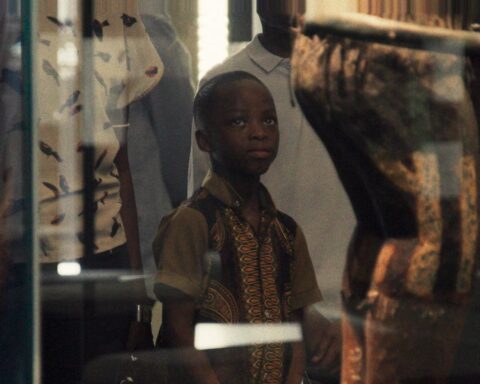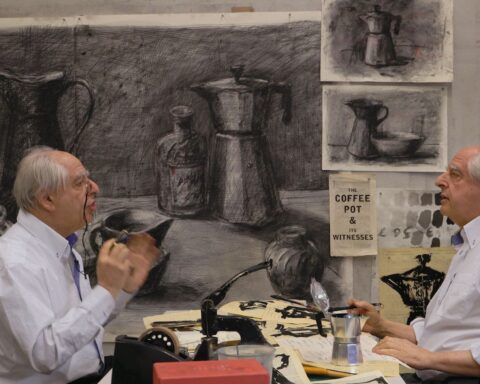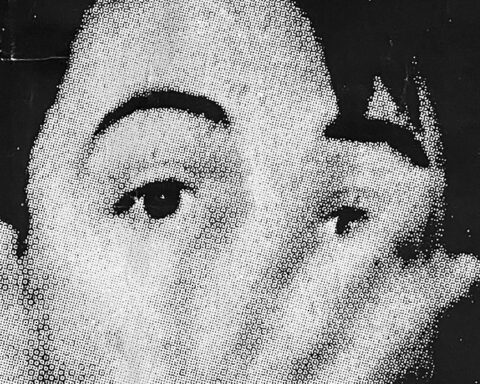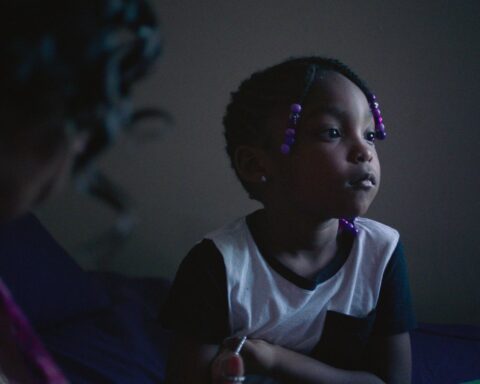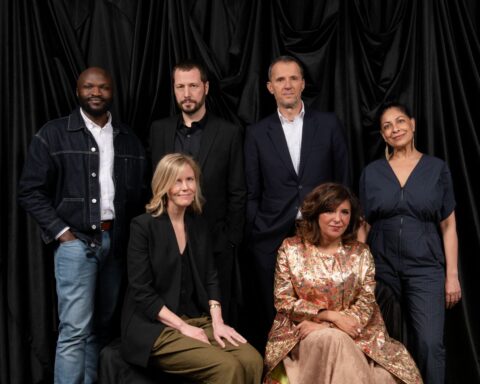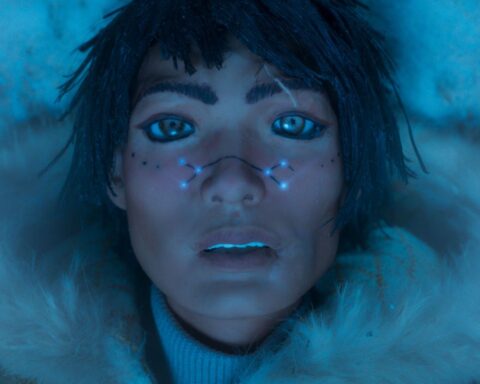The art and life of Jonas Mekas seamlessly blend together, and viewers have had the privilege to witness this intertwinement for six decades. He was, and is, at the center of the art world in general and New York in particular, crossing paths, meeting up and fostering collaborations with people like Andy Warhol, George Maciunas, John Lennon, Yoko Ono, Salvador Dalí, Ken Jacobs, Gregory Markopoulos, Allen Ginsberg, Nicholas Ray, Hans Richter, John Cage, and on and on.
Mekas created Film Culture (1954-1996), the first non-academic magazine dedicated to film criticism in the United States. In 1962, he started The Film-Makers’ Cooperative, an artist-run, non-profit avant-garde distributor. Two years later, Mekas founded the Film-Makers’ Cinematheque, which would later become Anthology Film Archives, a mecca for avant-garde cinema. And to top it off, he has a prodigious body of work that includes several masterpieces that merge documentary and avant-garde filmmaking. Filmmaker, promoter, programmer, critic, distributor, exhibitor, artist, writer, poet, diarist—the 94-year-old has done it all.
Earlier this year, Mekas kick-started his long-awaited plan to add on to Anthology Film Archives, building a café and a thirdfloor library dedicated to the archives, which contain one of the world’s largest collections of print materials on cinema, including Orson Welles’ shooting script for Citizen Kane (1941). To partially fund the $6-million-dollar project, he and Anthology organised a charity auction in March, featuring guests like Patti Smith and Jim Jarmusch, as well as artwork for sale by Matthew Barney, Chuck Close, Richard Serra, and more. The fundraising calls to mind a glimpse in Mekas’ Reminiscences of a Journey to Lithuania (1972) where we see Mekas in a suit with his hair combed. A title card reads, “Having Tea with Rich Ladies.” Now, metaphorically speaking, Mekas and his friends dress up to get patrons to bankroll the latest stage in Anthology’s life.
Excerpt from “Lost Lost Lost” by Jonas Mekas 1976 from Jonas Mekas on Vimeo.
As a filmmaker, Mekas is traditionally associated with avantgarde cinema. That label’s broadness leaves room for categories or sub-categories tied to the avant-garde. One such category, and a few of its iterations as we shall soon see, characterises Mekas’ cinema—documentary filmmaking. Although undercut by the rise of hybrid films, historically, documentary and avant-garde cinema have been considered diametrically opposing labels: The Lumière brothers represent nonfiction (Mekas dedicates Walden [1969] to them), Georges Méliès fiction. After the Lumières come Robert Flaherty and John Grierson, who introduced narrative, and therefore ideology, rhetoric and social change, to the documentary film. And yet, since the beginning of cinema, the two have been strange bedfellows. “The established story of documentary’s beginnings continues to perpetuate a false division between the avant-garde and documentary that obscures their necessary proximity” Bill Nichols writes in his article “Documentary Film and the Modernist Avant-Garde.” What ultimately drew modernist artists to cinema at the fin de siècle was its ability to combine “indexical representation” with montage, with the power to bend and warp time and space. Movies like Dziga Vertov’s The Man with a Movie Camera (1929), Paul Strand and Charles Sheeler’s Manhatta (1921), Luis Buñuel’s Land without Bread (1933) display this alchemical mixture of avant-garde and documentary film.
Not until the 1970s, according to Nichols, does the documentary shift its purpose. Its main role as an ideological tool—a function promoted by Grierson—was no more. More and more filmmakers began to use the documentary for a personal mode of expression. One of the first and foremost filmmakers to start using documentary as such was Jonas Mekas.
Mekas made a handful of low-budget narrative films in the early 1960s (Guns of the Trees [1961], The Brig [1964]), before switching to a radical autobiographical style with Diaries, Notes, and Sketches, also known as Walden (1969). At about three hours in run time, and split into six reels, Walden absorbs seemingly everything Mekas recorded during the mid-to-late 1960s, even providing brief flashbacks to the 1950s. Like all Mekas’ films to come afterwards, Walden is made up of fragments, bits and pieces of faded 16mm color and black-and-white footage that he edited in-camera. Many shots last fractions of a second. They consist of people, places, and things that have special meaning for Mekas. It’s his diary in which you can seemingly enter and exit at any point in the film. “I don’t make films, so to speak,” Mekas said in an interview with Artspace. “I just film. Later I put some of those notes together, organised either thematically or in general about my life, and I release them.” Mekas has been keeping a diary in different mediums for his entire life, first as a six-year-old drawing in Semeniškiai, Lithuania, then switching to writing, then to film in New York with his handheld Bolex camera, and later video.
“I make home movies, therefore I am,” Mekas says in post-sync voiceover narration in Walden’s first reel—an homage to Descartes’ cogito. Walden was never supposed to be shown publicly. The fragments in the reels were meant as exercises in which Mekas could master his Bolex camera. But, according to Joshua Mabe in The Moving Image, when an arts festival in New York asked Mekas if he had a film to show, he presented Walden, which the festival funded to completion. In fact, Walden is made up of several short films by Mekas that includes Report from Millbrook (1965-1966), Hare Krishna (1966), Notes on the Circus (1966) and Cassis (1966). Each has its own particular aesthetic; taken as a whole then, Walden’s look and feel morphs over its long running time. Personal moments (weddings, walks through Central Park, subway rides) rub shoulders with historical ones (John Lennon and Yoko Ono’s bed-in, nuclear war protests in Times Square).
In the 1970s, Mekas made another long personal film. “Walden is a diary; Lost Lost Lost [1976], shot mainly in somber black and white, is more a memoir,” wrote J. Hoberman for The New York Times. This film is Mekas’ immigrant narrative. Like Walden, it consists of six reels. Yet Lost Lost Lost is split even further into two parts. The first chronicles Mekas’ initial years in America, specifically Williamsburg, Brooklyn. In footage that has the texture and feel of conventional home movies, Mekas recounts his time spent with a community of Lithuanian displaced persons, especially at a gathering in Stony Brook, New York. In the second part, the film’s aesthetic changes, and is evocative of Mekas’ signature expressive, handheld, haptic style. Mekas moves to Manhattan with his brother, Adolfas, and joins a community of artists and filmmakers.
At first glance, Lost Lost Lost plays like Mekas’ most conventional work. But such a notion is undermined when you consider the entire film, for it is about Mekas’ growth as a person and artist. The first part in Brooklyn is in the past, and therefore is shot like conventional home-movie footage. The second part coincides with Mekas the artist. Form informs content as Mekas shoots in his improvisatory and sketch-like way. By the end of Lost Lost Lost, he returns to Stony Brook, this time with a bunch of new friends having fun at the beach. In effect, Mekas creates a palimpsest of memories associated with a place. While in scattered and brief shots Ken and Flo Jacobs, as well as a few others, goof off on the beach, Mekas’ intimate and poetic voiceover narration ends the film, referring to his onscreen self in the third person:
“Sometimes, he didn’t know where he was. The present and the past intermingled, superimposed […] He remembered another day 10 years ago. He sat on this beach 10 years ago with other friends. I have a memory of this place. I have been here before. I have really been here before. I have seen this water before. Yes, I have walked upon this beach, these pebbles.”
Excerpt from “Lost Lost Lost” by Jonas Mekas 1976 from Jonas Mekas on Vimeo.
Not only is it the culmination of the film, but the end also connects Mekas of the first part, the exile, with Mekas of the second, the artist. It is on that beach, where he once was so many years ago, that Mekas recaptures his memories.
In the wake of these two works, there has been an outpouring of autobiographical documentaries, which range in depth and breadth, and can be considered a subgenre of sorts. It includes films by Ed Pincus, Ross McElwee, Stephen Dwoskin, Joe Gibbons, David Perlov, Leo Hurwitz, and many more. One that shares affinities with Mekas’ work is Agnès Varda’s The Beaches of Agnès (2008). Moreover, the two filmmakers share similar backgrounds. Both are members of innovative film movements—New American Cinema and the French Left Bank New Wave (which included Chris Marker and Alain Resnais). Both participated in the film and art worlds by making movies and installations.
The Beaches of Agnès is Varda’s most personal work. “This time, to talk about myself, I thought, ‘if we opened people up we’d find landscapes,’” she says at the beginning of the film, talking directly to the camera. Then in voiceover: “If we opened me up, we’d find beaches.” Just as the title suggests, beaches provide the sections for the film as Varda recounts her life off the coasts of Arles, Belgium; Noirmoutier, France; and Los Angeles, California.
Varda’s film is more conceptual than Walden or Lost Lost Lost. The Beaches of Agnès is a film that considers a person made up of spaces. And yet, like Mekas’ films, Varda’s highlights the people tied to these spaces, the friends and family that make up her life. Even though she’s telling her story, Varda says to the camera, “it’s others I’m interested in, others I like to film. Others who intrigue me, motivate me, make me ask questions, disconcert me, fascinate me.” Having made a career of filming others, particularly the marginalised and the working class, Varda turns the camera on herself, and what it reveals is a life made up of people. In short, she’s connected to a community of strangers, friends, family and artists around the world.
The Beaches of Agnès diverges from Mekas’ cinema in a number of ways. First, there is more of a narrative thrust in Varda’s documentary, as she goes through her life for the most part linearly, including: her childhood in Arles; her university years; her decade stint as the official photographer of Théâtre National Populaire; her first forays in filmmaking with La Point Courte (1954) and the breakout success of Cléo from 5 to 7 (1961); her relationship with Jacques Demy; her travels to California; her late turn as an exhibition artist with her first show at the 2003 Venice Biennale, and more. More concrete and less abstract, Varda’s voiceover guides us along her life story, whereas Mekas’ is intimate, colloquial and filled with grammatical mistakes. Mekas’ work is more poetic, and therefore allows room for ambiguity. Not only using archival footage, mostly from Varda’s photos and movies, The Beaches of Agnès also demonstrates a formal hybridity. It recreates, reenacts and reconstructs memories from her life, which is something of a signature aesthetic choice for Varda.
What does this detour, this digression, this long parenthesis with Varda tell us about Mekas’ work? His films occupy one extreme of autobiographical documentaries, that of the avant-garde. In Walden and Lost Lost Lost, images appear without apparent logic. They are in the film simply for his pleasure, and perhaps yours, too. As Mekas says in Out-Takes from the Life of a Happy Man (2011): “this film…is just images, images with no purpose, just for myself and a few friends.” The details that emerge about his life from his films are sketchy and scattershot. Mekas is not filming for the sake of clarity, but to evoke a feeling, a sensation, that of memories and remembering. Varda is representing memories as well, but in a more recognisable form. “While I live, I remember,” Varda says in the last line of the documentary.
Autobiographical films are about memory because they deal with the past, with the filmmaker’s life history. In a deeply personal aesthetic, following an individual logic, Jonas Mekas and the autobiographical documentary conjure moments that are big and small, major and minor, mundane and extraordinary. They make up a life lived.




